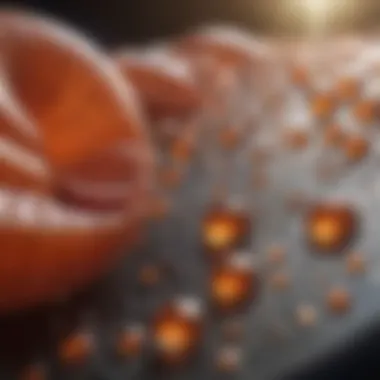Low Sodium Diet for Chronic Kidney Disease Benefits


Intro
Chronic kidney disease (CKD) presents significant challenges to individuals relying on their kidneys for essential bodily functions. This condition not only impacts kidney function but also affects overall health. In this context, dietary adjustments become crucial in managing CKD effectively. A low sodium diet stands out as a key dietary strategy to mitigate the adverse effects associated with this disease.
Sodium plays a vital role in regulating blood pressure, but excessive intake can lead to complications that worsen kidney function. Therefore, understanding the dynamics of sodium consumption and its correlation with CKD is essential for patients and healthcare providers.
In this article, we will explore the implications of reducing sodium intake, outline practical strategies for doing so, and highlight the benefits such changes can bring to the lives of those affected by CKD. As we delve into this topic, we will emphasize the importance of tailored dietary plans and provide actionable insights for managing sodium levels effectively.
Intro to Chronic Kidney Disease
Chronic kidney disease (CKD) represents a significant global health challenge affecting millions of individuals. Understanding CKD is crucial for both patients and healthcare providers, as it lays the groundwork for effective health management strategies. This article particularly emphasizes the connection between CKD and a low sodium diet, considering its importance in mitigating the condition's progression and improving overall quality of life.
Definition and Stages of CKD
Chronic kidney disease is characterized by a gradual decline in kidney function, often resulting from various underlying health conditions. The disease is classified into five stages, with stage one indicating normal kidney function and stage five representing end-stage renal disease requiring dialysis or kidney transplantation. The early stages of CKD may present little to no symptoms, often leading to late diagnosis and treatment.
Prevalence and Risk Factors
The prevalence of CKD has been rising across the globe, impacting diverse populations. Key risk factors include diabetes, hypertension, and cardiovascular disease. Lifestyle choices, such as poor diet, inactivity, and smoking, further contribute to the risk of developing CKD. Awareness of these factors is essential for prevention and early intervention, especially when it comes to dietary management.
"Understanding CKD not only aids in personal health management but also empowers healthcare professionals to offer better care and patient education."
Understanding Sodium's Role
Sodium is a vital element in our diet, but its impact on health is often complex. Understanding sodium's role is essential for those suffering from chronic kidney disease (CKD). In this section, we will delve into two main aspects: the physiological functions of sodium in the body and its specific interactions with kidney function. These insights will not only clarify why sodium matters but also present practical implications for managing CKD effectively.
Physiological Functions of Sodium
Sodium is primarily recognized for its role in fluid balance. It helps maintain normal blood pressure and is crucial in regulating blood volume. The body depends on sodium for many physiological functions, which includes grasping nerve impulses and aiding muscle contraction.
- Fluid Balance: Sodium attracts water. This characteristic ensures that water remains in the bloodstream and cells. Hence, altering sodium intake can significantly influence hydration levels.
- Nerve Function: Sodium ions are pivotal in generating electrical signals in neurons. This process is fundamental for functions like reflexes and communication between the central nervous system and muscles.
- Muscle Contraction: Sodium works in tandem with potassium to facilitate muscle contractions. For example, heart muscles need a delicate balance of sodium to function correctly.
Overall, sodium plays a multifaceted role and impacts several body processes. The relevance of sodium in kidney disease, however, extends beyond its general functions.
Sodium and Kidney Function
The kidneys play a crucial role in filtering excess sodium from the blood. As CKD progresses, the kidneys lose their ability to eliminate sodium effectively. This inefficiency results in fluid retention and can lead to hypertension. High blood pressure adds further strain on the already compromised kidneys.
When sodium levels in the body rise, it can cause:
- Edema: Swelling due to fluid retention in tissues, posing additional challenges for CKD patients.
- Increased Blood Pressure: Elevated sodium leads to higher blood pressure, compounding the stresses on kidney functionality.
- Accelerated Kidney Damage: Continued high sodium consumption might progress CKD, increasing the risk of cardiovascular issues.
It is crucial for individuals with CKD to recognize these connections. Once sodium intake is monitored closely, patients can begin to mitigate some of these risks.
"Monitoring sodium intake is not just a dietary choice; it's a crucial strategy in CKD management."
Through understanding sodium's diverse functions and implications for kidney health, individuals with chronic kidney disease can make informed dietary choices that align with their health goals.
The Importance of a Low Sodium Diet
Chronic kidney disease (CKD) poses significant challenges not only to kidneys but also to overall health and well-being. One of the most effective dietary strategies to manage CKD is the reduction of sodium intake. A low sodium diet becomes crucial as it helps manage symptoms, enhance health outcomes, and prevent further kidney damage. This section underscores the key reasons why a low sodium diet is essential for individuals with CKD.
Benefits for CKD Patients
Reducing sodium intake can have multiple benefits for patients suffering from CKD.


- Fluid Balance: Lower sodium helps manage fluid retention, which is a common complication in kidney disease. This can alleviate swelling and improve blood pressure control.
- Blood Pressure Management: Sodium intake is closely linked to blood pressure levels. By keeping sodium low, CKD patients can better manage hypertension, which is critical to reduce cardiovascular risks.
- Kidney Function: A low sodium diet supports kidney function by reducing the workload on these organs. Less sodium means less effort needed by kidneys to excrete sodium and maintain balance.
- Long-term Health Outcomes: Studies indicate that patients adhering to low sodium diets tend to experience slower progression of CKD. Improved management can lead to a better quality of life and prolonged kidney function.
These benefits highlight the pivotal role of dietary choices in managing CKD and improving overall health.
Connection Between Sodium and Hypertension
The relationship between sodium intake and hypertension is well-documented in medical literature.
- Sodium as a Risk Factor: High sodium levels stimulate fluid retention, leading to increased blood volume and pressure. This places additional strain on the cardiovascular system, especially in CKD patients who are already at higher risk of cardiovascular diseases.
- Mechanisms of Hypertension: Excess sodium can cause blood vessels to constrict, further elevating blood pressure. For individuals with compromised kidney function, this can exacerbate their condition and lead to severe complications.
- Managing Hypertension: By adopting a low sodium diet, CKD patients can significantly lower their blood pressure. This change is vital as high blood pressure can accelerate kidney damage and increase the risk for other health complications.
In summary, the link between sodium intake and hypertension serves as a critical reminder for CKD patients to monitor and restrict their sodium consumption. The importance of this dietary modification cannot be overstated as it plays a fundamental role in the management of CKD and overall health.
Guidelines for Reducing Sodium Intake
Reducing sodium intake is an essential step for individuals managing chronic kidney disease (CKD). This process not only improves kidney function but also minimizes further complications related to high sodium consumption, such as hypertension and cardiovascular diseases.
A low sodium diet can significantly enhance the quality of life for CKD patients, assisting in the maintenance of fluid balance and regulation of blood pressure. It is important for patients to understand various strategies to effectively lower their sodium intake. This section provides comprehensive guidelines aimed at creating a healthier dietary environment for those living with CKD.
Revising Food Choices
Choosing the right foods is a fundamental part of a low sodium diet. Patients with CKD should focus on whole, unprocessed foods whenever possible. Fresh fruits and vegetables, lean proteins, and whole grains are often lower in sodium compared to their processed counterparts.
- Fresh fruits: Options like apples, oranges, and berries offer essential nutrients without added sodium.
- Vegetables: Leafy greens like spinach and kale are nutritious choices.
- Lean meats: Skinless chicken or turkey and fish are preferable sources of protein.
Processed foods, such as canned soups, sauces, and frozen meals, usually contain high levels of sodium. Opting for sodium-free or low-sodium versions of these items is crucial. It's also wise to limit the intake of snack foods like chips and pretzels, as these tend to be high in sodium.
Understanding Food Labels
Reading food labels is a vital skill for managing sodium intake. The nutrition facts panel provides insight into what one is consuming. CKD patients should look for products labeled as "low sodium" or "sodium-free".
To understand labels better, follow these key points:
- Sodium Content: Aim for products with 140 mg of sodium or less per serving.
- Serving Size: Keep in mind that many packages contain multiple servings; adjust the sodium total based on consumption.
- Ingredients List: Sodium can be found in many forms. Words like sodium chloride, baking soda, and monosodium glutamate (MSG) indicate the presence of sodium.
Awareness of these factors can help patients make informed choices and avoid hidden sodium.
Cooking Techniques to Limit Sodium
Cooking methods can significantly impact sodium levels in meals. Adopting healthier cooking techniques can reinforce a low sodium diet. Consider these strategies:
- Use herbs and spices: Experiment with garlic, pepper, or lemon juice instead of salt to enhance flavor.
- Fresh pressure cooking: This method allows food flavors to intensify, often reducing the need for added salt.
- Grilling or baking: Techniques that allow fats to drip away can promote healthier eating without excess sodium.
By incorporating these cooking methods and focusing on fresh ingredients, CKD patients can maintain a flavorful diet while adhering to sodium restrictions.
"Proper dietary changes are crucial for CKD management. Simple adjustments can lead to significant health benefits."
Practical Strategies for Adopting a Low Sodium Diet
In managing chronic kidney disease (CKD), adopting a low sodium diet is pivotal. It not merely serves as a dietary preference but becomes a necessary lifestyle adjustment aimed at both improving renal function and reducing hypertension. Effective strategies provide a pathway that enables patients to achieve their dietary goals without feeling deprived.
Meal Planning and Preparation
Rigorous meal planning and thoughtful preparation can facilitate a low sodium diet effectively. Begin by creating a weekly meal plan that emphasizes fresh, whole foods. Focus on incorporating a variety of fruits, vegetables, whole grains, and lean proteins. These food types are usually lower in sodium compared to processed foods.
To manage portion sizes and ingredients, consider the following approaches:
- Use fresh or frozen vegetables instead of canned options, which often contain added sodium.
- Opt for herbs and spices in place of salt for flavor enhancement. Examples are garlic, basil, and cumin.
- Cook from scratch whenever possible. This enables control over the sodium content of meals.
- Batch cooking can save time and help ensure that low sodium meals are readily available. Packages can be made to freeze for future use.


Organizing grocery shopping trips is also a key aspect. Create a shopping list aligned with your meal plan to avoid impulsive purchases, which can lead to selecting high-sodium items. Stick to the outer aisles of the grocery store where fresh foods are usually displayed.
Snack Alternatives with Low Sodium
Additionally, finding suitable snack alternatives is important for adherence to a low sodium regimen. Many packaged snacks contain high levels of sodium, so turning to healthier choices is key.
Consider these options:
- Fresh fruits and vegetables: Carrot sticks, cucumbers, and apple slices provide crunch and nutrition without added sodium.
- Unsalted nuts and seeds: These are good sources of protein and healthy fats.
- Homemade popcorn: Air-popped corn seasoned with herbs can serve as a low sodium treat.
- Rice cakes: They can be topped with nut butter or a light spread of avocado for additional flavor.
By being intentional about snack selection, patients can avoid hidden sodium traps while satisfying cravings and providing nourishment. These adjustments to meal and snack planning not only ease adherence to a low sodium diet but also enhance overall health and well-being.
A low sodium diet benefits CKD patients by supporting kidney function and managing blood pressure, making dietary adjustments essential for long-term health.
Implementing these practical strategies allows individuals with CKD to create a sustainable and enjoyable dietary lifestyle, ultimately contributing to better health outcomes.
Scientific Evidence Supporting Sodium Reduction
Scientific evidence plays a crucial role in understanding the impact of sodium reduction, particularly for individuals with chronic kidney disease (CKD). Research studies indicate a strong correlation between sodium intake and various renal outcomes. Therefore, comprehending this evidence is essential for both patients and healthcare providers seeking effective dietary interventions.
Clinical Studies on Sodium and CKD
Numerous clinical studies have assessed the effects of low sodium diets on CKD patients. These investigations consistently demonstrate that reducing sodium can lead to improved blood pressure control and decreased proteinuria, which is the presence of excess protein in urine. For instance, one significant study published in the Journal of the American Society of Nephrology illustrated that a sodium-restricted diet effectively lowered blood pressure in CKD patients, ultimately leading to a slowing of kidney function decline. Additionally, other studies have shown that a reduction in sodium intake results in enhanced kidney health over time.
Outcomes from these clinical trials often highlight how sodium reduction lowers the risk of cardiovascular complications associated with CKD. The importance of these findings cannot be overstated, as heart disease is a leading cause of death among CKD patients. Therefore, incorporating a low sodium approach is increasingly seen as a necessary measure in managing CKD.
Long-term Health Outcomes
The long-term health outcomes of reducing sodium intake in CKD patients are promising. Various studies demonstrate that maintaining a low sodium diet over time correlates with improved hospitalization rates, better quality of life, and increased longevity. For instance, a longitudinal study revealed that patients adhering to a low sodium regimen showcased a significantly lower risk of developing end-stage renal disease (ESRD).
Moreover, the reduction of sodium intake not only benefits kidney health but also plays an integral role in managing associated conditions such as hypertension and heart failure. Patients who manage their sodium intake effectively often experience fewer complications, leading to a more stable health trajectory.
"Long-term adherence to a low sodium diet results in fewer hospitalizations due to renal-related complications."
In summary, the scientific evidence supporting sodium reduction in CKD patients highlights both immediate and long-term benefits. By understanding these connections, individuals can make informed dietary choices that may significantly enhance their overall health outcomes.
Challenges in Reducing Sodium Intake
A low sodium diet presents significant challenges for individuals with chronic kidney disease (CKD). Understanding these obstacles is crucial for effective dietary management. Many patients face various barriers that complicate their ability to adhere to a low sodium regimen. Addressing these challenges can greatly enhance the quality of life and health outcomes of CKD patients.
Social and Cultural Factors
Social and cultural influences play a vital role in dietary habits. Food is often a central part of gathering and communal experience. In many cultures, traditional dishes are rich in flavors, often achieved through the use of salt and sodium-rich seasonings.
Patients might feel hesitant to modify recipes or avoid certain foods during family meals. This reluctance can lead to increased sodium intake that contradicts dietary recommendations. Moreover, social situations such as celebrations or holidays often include foods that are higher in sodium, making it difficult for individuals to remain compliant with their dietary restrictions.
To navigate these challenges, education on alternative flavoring methods might be beneficial. Herbs and spices can provide flavor without adding sodium, allowing individuals to enjoy meals with family and friends while adhering to a low sodium diet.
Taste Preferences and Adaptation
Taste preferences develop over time and can significantly influence dietary choices. Many individuals accustomed to higher sodium intake may find low sodium foods bland or less satisfying at first. This presents a real challenge to adopting a low sodium diet.
To counteract this, gradual reductions in sodium can help adjust the palate. Instead of eliminating sodium entirely at once, patients can start by reducing their intake slowly. This process helps to adjust taste buds and improve acceptance of less salty foods. Furthermore, incorporating diverse flavors can help in making low sodium meals enjoyable.
Role of Healthcare Providers
Healthcare providers play a pivotal role in the management of chronic kidney disease (CKD), especially concerning dietary modifications like adopting a low sodium diet. Their guidance is essential for patients navigating the complexities of dietary changes and understanding the associated health implications. Not only do they provide critical medical insights, but they also help in formulating personalized dietary plans that cater to each patient’s specific health status and dietary requirements.


The integration of a low sodium diet in the treatment plan for CKD patients can significantly improve health outcomes. Providers educate patients about the risks associated with excessive sodium intake, including the exacerbation of hypertension and fluid retention, which can ultimately lead to worsened kidney function. By fostering open dialogues, healthcare professionals can ensure patients understand the importance of sodium reduction and encourage compliance with dietary recommendations.
Educational Strategies for Patients
Effective education strategies are crucial in enhancing patient understanding and adherence to a low sodium diet. Providers often use the following methods in their approach:
- Visual Aids: Charts and models can illustrate healthy food choices and sodium levels, making the information more tangible.
- Workshops and Group Sessions: These forums allow sharing experiences and tips among patients, which can facilitate learning through peer support.
- Customized Handouts: Providing material specific to individual dietary needs, including examples of low sodium meals, helps patients make informed choices.
Additionally, healthcare providers should emphasize the long-term benefits of maintaining a low sodium diet, reinforcing that changes made today can have positive effects on kidney health in the future.
"Education empowers patients to take charge of their health, especially in chronic conditions like CKD."
Monitoring Sodium Intake
Monitoring sodium intake is a fundamental part of managing CKD through diet. Healthcare providers can assist patients in tracking their sodium consumption in several effective ways:
- Food Journals: Encouraging patients to maintain a daily log of their food intake, along with the sodium content, can help raise awareness about what they consume.
- Apps and Technology: Educating patients on utilizing nutrition tracking apps can simplify monitoring sodium levels.
- Regular Check-ups: Frequent consultations can help providers assess the patient's adherence to the dietary plan and make adjustments as necessary.
The role of healthcare providers extends beyond just education; it involves fostering a supportive environment where patients feel comfortable discussing difficulties in adhering to a low sodium diet. Providers can guide patients, ensuring they feel empowered to make dietary changes that are beneficial and practical in their daily lives.
Future Directions in CKD Dietary Management
The management of chronic kidney disease (CKD) continues to evolve, especially in the realm of dietary interventions. As researchers, clinicians, and dietitians work collectively, it becomes evident that the landscape of dietary management is broadening. Future directions focus on enhancing patient outcomes through more tailored, evidence-based dietary practices. The emphasis on sodium reduction will remain a focal point due to its impacts on kidney health and overall well-being.
Emerging Research on Sodium Intake
Emerging research indicates that the traditional recommendations for sodium intake in CKD patients may need reevaluation. New studies have started to provide a nuanced understanding of how salt affects kidney function, blood pressure, and fluid balance in individuals with varying stages of CKD. For example, recent clinical trials suggest that even mild reductions in dietary sodium can lead to significant improvements in hypertension management among CKD patients. These findings underline the potential for more individualized sodium intake guidelines based on patient needs and responses.
Key considerations from the current research include:
- Individual Variability: Not all CKD patients react to sodium in the same way. Personalized intake recommendations can optimize treatment.
- Long-term Effects: Understanding the long-term consequences of low sodium diets on kidney health warrants further study.
- Alternative Sources of Flavoring: There is a growing exploration of herbs and spices as alternatives to sodium.
"Adjusting sodium intake is not just about cutting back; it's about finding a balance that supports kidney health while maintaining quality of life."
Interdisciplinary Approaches to Treatment
The complexity of managing CKD necessitates an interdisciplinary approach. Diet is one facet of treatment, but it must be integrated into a broader healthcare strategy. This involves collaboration between nephrologists, dietitians, nurses, and primary care physicians. Each professional brings unique insights into the patient’s health trajectory.
Central elements in this approach include:
- Shared Decision-Making: Patients should be involved in discussions about dietary changes, enabling them to comprehend the implications fully. This empowerment can lead to better adherence to dietary modifications.
- Monitoring and Support: Regular check-ins with healthcare providers allow for tracking sodium intake and its effects on kidney function, enabling timely adjustments to the dietary plan.
- Educational Programs: Initiatives that inform patients about the importance of low sodium diets can enhance their ability to make informed choices.
The future directions in CKD dietary management highlight the importance of adaptability, ongoing research, and collaboration among healthcare disciplines. This holistic approach is crucial for fostering better health outcomes in CKD patients.
The End
The conclusion in this article serves as the synthesis of information presented on the low sodium diet for individuals dealing with chronic kidney disease (CKD). A low sodium diet is not only a dietary recommendation but an essential component of managing CKD effectively. This section emphasizes the importance of adopting a low sodium lifestyle, offering both immediate and long-term benefits to kidney health and overall well-being.
One major point is that lowering sodium intake can lead to better blood pressure control. This is crucial, as CKD patients are at higher risk for hypertension. It can also help to reduce fluid retention, which is common in those with kidney issues, thus decreasing the burden on the kidneys themselves. A deliberate reduction in sodium can facilitate improved kidney function and slow the progression of the disease.
Moreover, the conclusion highlights the considerations necessary for incorporating a low sodium diet into daily life. It addresses potential challenges, such as taste preferences and social factors, while also acknowledging the vital role of healthcare providers in guiding patients through these dietary transitions. Patients must be proactive and consistent in implementing these changes for the best outcomes.
The conclusion encapsulates the idea that managing CKD through diet is an ongoing endeavor. A low sodium diet goes beyond just limiting salt; it encompasses a comprehensive lifestyle adjustment. Embracing this dietary approach can set the stage for improved health and a better quality of life for CKD patients.
Summary of Key Points
The following points summarize the crucial aspects discussed throughout the article:
- Importance of Sodium Management: Sodium plays a significant role in kidney function, and its reduction can enhance health outcomes for CKD patients.
- Blood Pressure Control: A low sodium diet can effectively manage hypertension, a common issue for individuals with CKD.
- Dietary Modifications: Practical strategies for reducing sodium intake include meal planning, understanding food labels, and learning healthier cooking techniques.
- Support from Healthcare Providers: Proper guidance from healthcare experts is essential to navigate dietary adjustments effectively.
- Challenges and Adaptation: Awareness of the difficulties in reducing sodium intake, including social pressures and taste preferences, is critical for adapting successfully to a new diet.
Final Thoughts on Dietary Management
In closing, managing chronic kidney disease through dietary choices is paramount. Adopting a low sodium diet not only addresses immediate health risks but also lays a foundation for long-term wellness. It requires a shift in perspective, where careful food selection becomes integral to everyday life.



